Text
📍中国 · 河北 · 承德 【 避暑山庄 】
The Mountain Resort
避暑山庄建于1703-1792年,经康熙、雍正、乾隆三朝历时89年建成,是清帝驻跸消暑、治政礼佛、怀柔外藩、现固边防的夏宫。避暑山庄占地564万平方米,是中国现存规模最大的古典皇家园林。山庄内西北为山岳区、东南为湖泊区、东北为平原区,整体形貌宛如中华版图。山庄造园取法自然,不假雕饰,120余组建筑掩映于山水草木之间,构成融南秀北雄于一体、集全国名胜于一园的壮美景观。

丽正门:是乾隆三十六景第一景,避暑山庄九门之首。初建于康熙年间,重修于乾隆十九年(1754)。门南向,上建城堞和阙楼。丽正门门额为乾隆帝御题。“丽正”二字出自《易经•离卦》:“日月丽乎天,百谷草木丽乎土,重明以丽乎正,乃化成天下。”意思是说:帝王就像日月依附于天、植物依附于地那样依附于正道,才能教化统治天下。
LiZheng Gate is the first scene of Qianlong's 36 scenery, the first of the nine gates in the Mountain Resort. Originally built in Emperor Kangxi period, it was rebuilt in the 19" year Emperor Qianlong's Reign (1754). The Gate is south facing, and the wall and the tower are built on the top. The title"Lizhengmen" is by Emperor Qianlong. The word "Lizheng" comes from the Book of Changes, an ancient prediction book. It means that emperors' rule should follow the right direction as the sun and the moon attach to the heaven, and plants attach to the earth in order to dominate the world well.
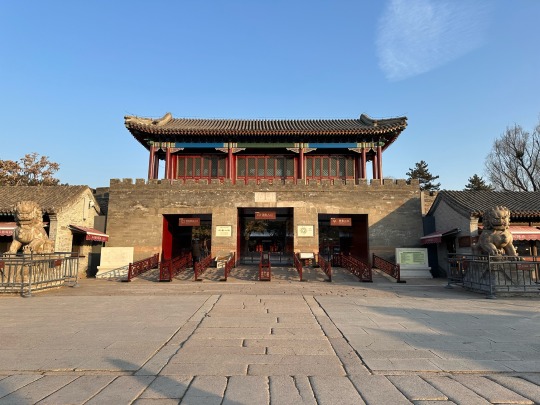

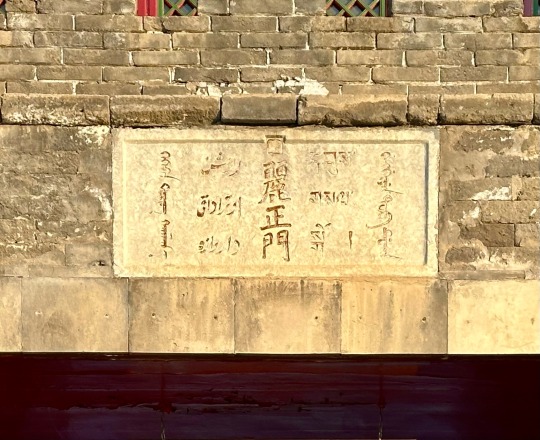
澹泊敬诚殿:建于康熙五十年(1711),乾隆十九年(1754)用楠木改建。康熙帝御题“澹泊敬诚”。“澹泊〞源于《易经》之“不烦不扰,澹泊不失”,意为“静以修身,俭以养德〞。此殿是清帝举行重大庆典、接受百官朝觐、接见少数民族首领和外国使节的地方。
Danbo Jingcheng Hall (Hall of Simplicity and Piety) was built in the 50th year in the reign of Emperor Kangxi (1711) and reconstructed by Emperor Qianlong with Phoebe zhennan in the 19th year in the reign of Emperor Qianlong (1754). Emperor Kangxi inscribed the hall "Dan Bo Jing Cheng", which is from Chinese classical book Changes, that a King should follow the discipline of "Quietude promotes learning. Frugality cultivates virtue." It used to be an important place where the Qing emperors held major celebrations, summoned officials and received leaders of ethnic minorities and foreign envoys.


烟波致爽殿:建于康熙四十九年(1710),康熙三十六景之第一景。因热河 “四围秀岭、十里澄湖、致有爽气”,故康熙帝御题“烟波致爽”。殿内设明厅、暖阁、佛堂,为清帝寝宫,嘉庆、咸丰二帝均驾崩于此。1860年,咸丰帝在此签准《北京条约》。
Yanbo Zhishuang Hall (Hall of Refreshing Mist) was built in the 49' year in the reign of Emperor Kangxi (1710) as the first of Emperor Kangxi's Thirty-Six Views. Emperor Kangxi entitled it as "Yan Bo Zhi Shuang" due to Rehe, the place where the Mountain Resort is located is surrounded by beautiful mountains and lakes that could bring coolness in hot summer. As the residence of Qing emperors, there is a bright living room, a warm bedroom and a Buddhist shrine inside. Emperor Jiaqing and Emperor Xianfeng died here. Emperor Xianfeng signed the Treaty of Beijing here in 1860.




2 notes
·
View notes
Text
📍中国 · 河北 · 石家庄 · 正定 【 隆兴寺 】
Longxing Temple
五彩悬山:长15.7米,高7.5米,以雕塑与绘画相结合的壁塑艺术形式,将观音说法的道场——普陀洛珈山壮观热烈的场景微缩于壁面。踞坐正中的观音菩萨,突破了宗教佛像的呆板作风,形体曲线柔美,姿态优雅端庄,是诠释宋代观音造像世俗化特点的上乘之作,故被誉为“东方美神”。又因其坐南面北,与大殿坐向相背,又称“倒坐观音”,是隆兴寺六最之一。
Five Colored Suspension Gable Roof
The five color overhanging gable roof is 15.7 meters in length and 7.5 meters in height, miniaturizing magnificent and fervent scene in Putuo Luojia Mountain, the Bodhimanda where Avalokitesvara made the presence and spoke the dharma. Avalokitesvara sitting in the middle breaks through the rigid style of religious idle with the graceful figure and elegant posture. It's the best work to interpret the secular characteristic of Avalokitesvara figure in the Song Dynasty, thus called the Beauty of the East. Also, it sits in the south and faces north, on the contrary to the hall's sitting direction, so it's also called Reversely Sitting Avalokitesvara. It's one of the six best of Longxing Temple.



摩尼殿:建于北宋皇祐四年(1052年),面阔和进深均为七间,重檐歇山顶,殿身四面正中各出一山花向前的歇山式抱厦,平面布局呈十字形。檐下斗拱宏大,分布疏朗;柱子用材粗大,有明显卷刹、侧角和升起,与宋《营造法式》相近。为隆兴寺现存古建筑中价值最高的一座,隆兴寺六最之一。
Manichaean Hall
Manichaean Hall was built in the fourth year of Huangyou Reign in Northern Song Dynasty (1052), with seven rooms in both width and depth, double eaves, saddle roof and gabled porches on four sides. Its plane layout takes on a shape of crossing. The bucket arches are grand with a simple and clear distribution under eaves. The pillars are of robust materials, with the top in an obvious arc, side angle and rising, and typical of the Song architecture. As the most valuable building, the hall is one of the six best constructions in Longxing Temple.



铜铸千手千眼观音菩萨像:为北宋开宝四年(971年)奉太祖赵匡胤之命铸造,像高21.3米,位居我国古代铜造像之首。其42臂中除当胸双手合十外,两侧各20臂呈辐射状分布,手不仅分别执日、月、净瓶、金刚杵、宝剑等法器,且均饰有一眼,以40只手眼配以佛教三界中二十五种果报即为千手千眼之来历,千手表示护持众生,千眼表示观照世间。此像作为一千多年前劳动人民聪明与智慧的结晶,可谓我国古代治金史上的一大奇迹。在隆兴寺六处文物之最中最具影响力。
The Bronze Statue of Thousand Hand and Thousand-Eye Avalokitesvara
It was built with the order of Emperor Zhao Kuangyin in the fourth year of Kaibao Reign in the Northern Sang Dynasty (971). The statue is 21.3 meters in height, making it the highest among all bronze statues in ancient China. Among its 42 arms, except for two in front of the chest putting palms together, the rest arms are stretched in turn with 20 arms on either side. The hands are not only equipped with sun, moon, kalasa, vajry pestle, sword and other implements, but also decorated with eyes on each of them. To represent the twenty five retributions in the three worlds in Buddhism with the 40 hands and eyes is jut the origin of thousand-hand and thousand-eye. The thousand-hand means the protection to all human beings, while the thousand-eye means the observation to the secular world as the crystallization of the intelligence and wisdom of the working people more than one thousand years ago. The statue can be really said as a magic in the ancient metallurgical history of China. It's the most influential one among the six best of Longxing Temple.

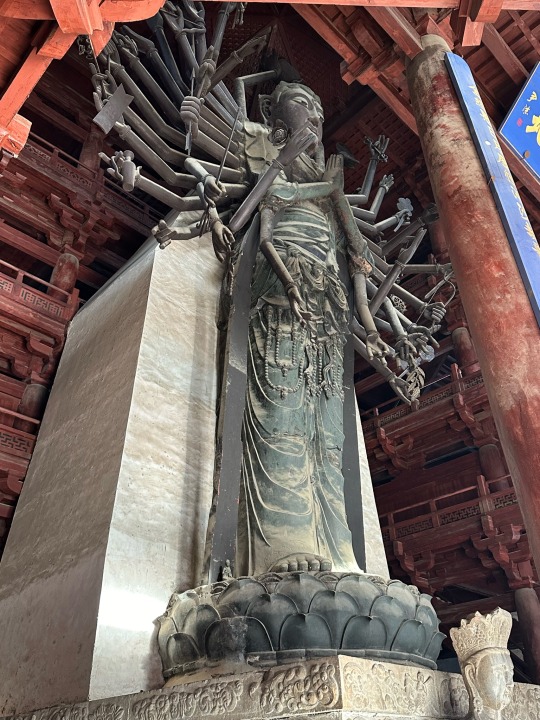


2 notes
·
View notes
Text
📍中国 · 天津 · 蓟州 【 独乐寺 】
Dule Temple
山门,辽代建筑,是我国现存最早的庑殿顶山门。山门高约10米,面阔三间,进深两间,明间作穿堂。山门正中悬挂匾额 “独乐寺”,为明代内阁首辅、大学士严嵩手书。雄硕的斗栱相当立柱的二分之一,排列疏朗,粗壮有力,颇具唐代风格。山门前两稍间为辽代金刚力士塑像,俗称“哼”、“哈”二将。后两稍间“四大天王”壁画为清代绘制,寓意风调雨顺。
The temple gate, the Liao Dynasty architecture, is the earliest existing hipped roof gate in China. The gate is about 10 meters in height, three-beam distance in width and two-beam distance in depth, using the central room as the hallway. In the middle of the gate hangs a horizontal inscribed board titled "Dule Temple", which is the calligraphy of the cabinet prime minister and great scholar Yan Song of the Ming Dynasty. The magnificent Dougong is a half of the stand column, arranged clearly and very strong and has the style of the Tang Dynasty.In the two wing rooms before the gate, there are the Vajra Powerful Lord statues of the Liao Dynasty called"Un" and "Ah". In the two back wing rooms, there are frescos of "Four Deva Kings" painted in the Ming Dynasty, which reflect good wishes for harvest of ancient working people.
观音阁,辽统和二年(984)重建,是我国现存最古老的木结构楼阁。观音阁面阔五间,进深四间,通高23米,三层,歇山顶。观音阁设计匠心独具,全部结构围绕中间的巨型观音像建造,二十八根立柱形成内外两圈有序排列,用梁枋斗栱结成一个整体,赋予建筑巨大的抗震能力。斗栱由于位置、功能的不同,式样多达二十四种,使建筑更显气宇轩昂、宏伟壮观。
The Avalokitesvara Pavilion, rebuilt in the second year of Tonghe of the Liao Dynasty (984), is the oldest China's existing wooden structure pavilion. Avalokitesvara Pavilion is five-beam distance in width, four-beam distance in depth, and 23 meters in height, with three layers and gable and hip roof. With unique design, all the structures of the Avalokitesvara Pavilion are built around the huge standing Avalokitesvara Statue in the middle, twenty-eight stand columns form the inside and outside two circles and arrange orderly, combined with Liang Fang Dougong into a whole, which give the architecture great shock resistance capability.Due to different locations and functions, the type of Dougong is over twenty-four, which makes the architecture more imposing and spectacular.
观音阁中央须弥台上矗立着三尊辽代塑像,主像因冠顶置十个小佛头,加上本面,称十一面观音,高16.08米,为我国现存最高大的泥塑站像。两侧胁侍菩萨像高3.2米,身着护甲,站姿动感优美,造型生动活泼。三尊塑像皆承袭唐代风格,又具辽代特征,艺术水平高超,堪称辽代泥塑巅峰之作。
In the middle of the Avalokitesvara Pavilion, on the Sumeru platform stand three statues of the Liao Dynasty, around the crown of the main statue, there are ten small Avalokitesvara's heads, with its own face, called 11 faces Avalokitesvara, 16.08 meters high, is the biggest existing clay sculpture standing statue in China. The attendant Avalokitesvaras on the two sides are 3.2 meters high, wearing armor, with beautiful and dynamic standing posture and lively shape.The three statues are with both the Tang Dynasty style and Liao Dynasty characteristics, its high art level can be called the peak of the clay sculpture in the Liao Dynasty.


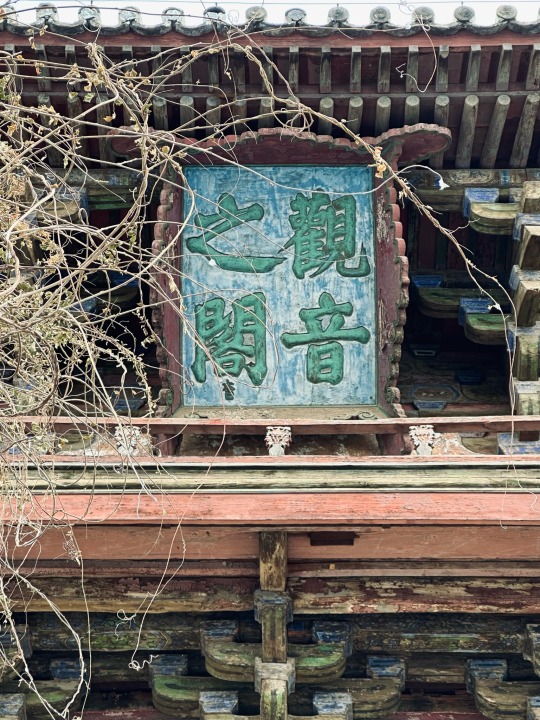





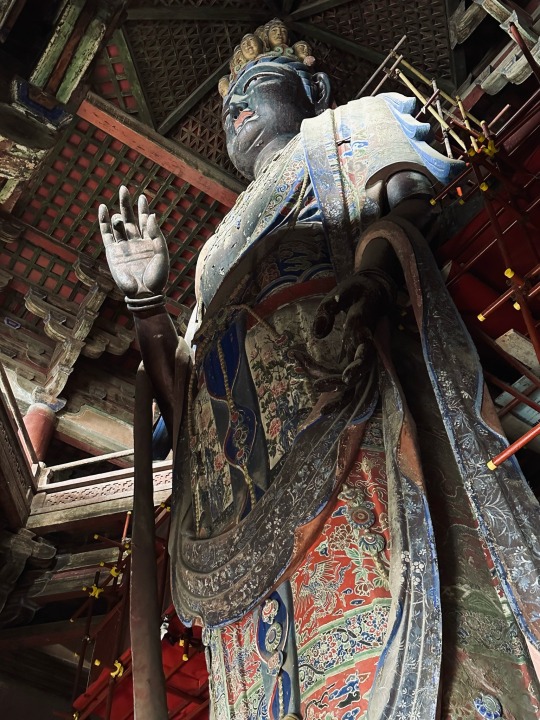
1 note
·
View note
Text
📍中国 · 辽宁 · 锦州 【 奉国寺 】
Fengguo Temple
The main building of Fengguo temple, the main hall, is a five ridge single eaves veranda building supported by a wooden structure frame composed of beams, columns, braces, buckets and arches. Its surface is 9 rooms wide, 55 meters wide and 5 rooms deep, 33 meters wide, implying "the supreme of the Ninth Five year plan".The main hall of Fengguo temple is a wooden building with the largest scale and the highest grade and specification among the relics of ancient Buddhist temples in China. It is known as "the first main hall in China". Its vigorous and magnificent appearance fully shows the infinite charm of ancient Chinese architectural art, its exquisite architectural technology The excellent structural design and the ultimate aesthetic art represent the highest level of Chinese architecture in the 11th century and can be regarded as a model of the perfect integration of Chinese ancient architecture and art.
奉国寺主体建筑大雄殿是以梁、柱、枋、斗、拱组成木结构框架作为支撑的五脊单檐庑殿式建筑,其面阔9间通宽55米进深5间通宽33米,寓意“九五至尊”。奉国寺大雄殿是中国古代佛教寺院遗存中规模体量最大、等级规格最高的木构建筑,被誉为“中国第一大雄宝殿”,其雄浑伟丽的体貌充分展示出中国古代建筑艺术的无穷魅力,其精湛的建筑技艺、绝妙的结构设计和极致的美���艺术代表着十一世纪中国建筑的最高水平,堪称中国古代建筑与艺术完美融合的典范。
In the Daxiong Hall of Fengguo temple, there are the world's oldest, largest and most exquisite painted clay Buddha statues of the Liao Dynasty."the past seven Buddhas", as well as precious cultural heritages such as threatening Bodhisattvas, Vajra warriors, Liang Jia color paintings of the Liao Dynasty, murals of the yuan and Ming dynasties, inverted Guanyin statues of the Ming Dynasty, and many steles, plaques and stone carvings of the Jin, yuan, Ming and Qing Dynasty.
奉国寺大雄殿内,遗存有世界最古老、最宏大、最精美的辽代彩绘泥塑佛像群“过去七佛”,以及胁侍菩萨、金刚力士、辽代梁架彩画、元明两代壁画、明代倒坐观音像和众多金、元、明、清时期的碑刻、匾额、石雕等珍贵文化遗产。

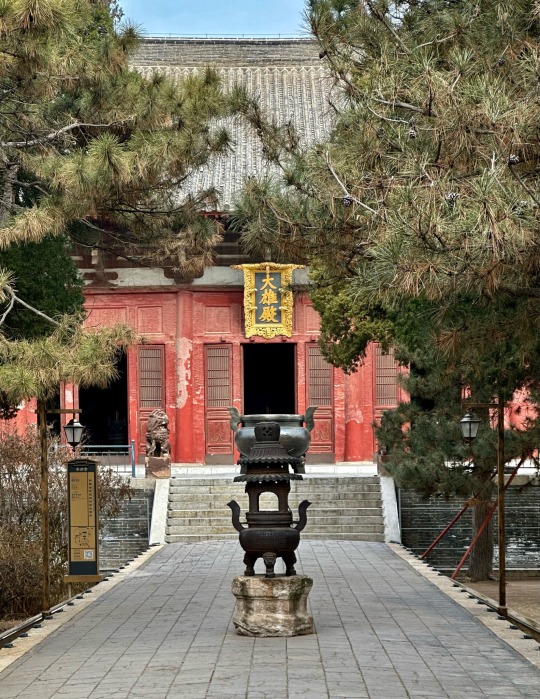




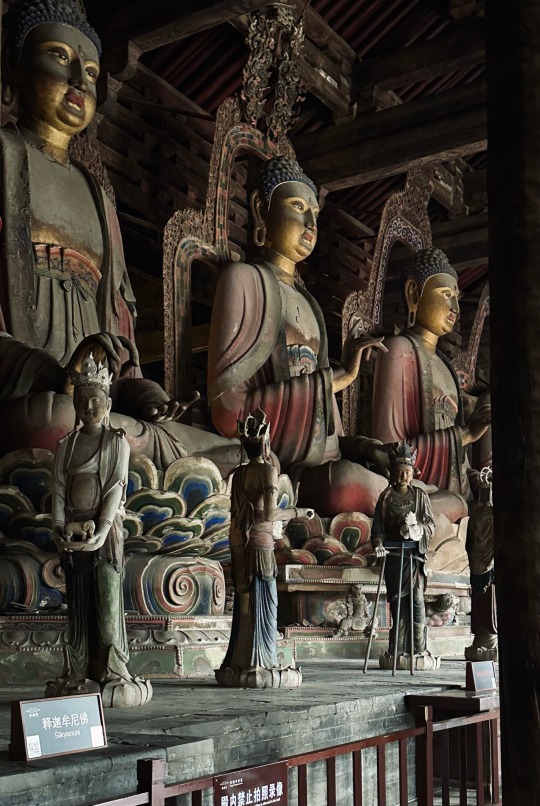
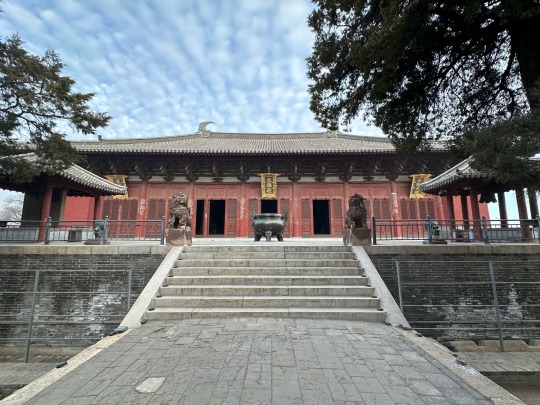

3 notes
·
View notes